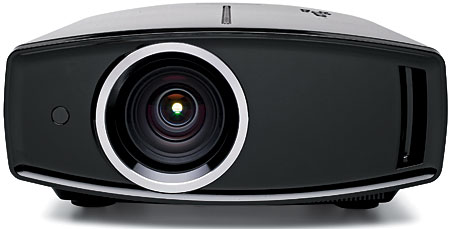JVC DLA-HD350 D-ILA Projector
 Price: $4,500 At A Glance: Excellent black level and shadow detail • • Bright, crisp image • Oversaturated color
Price: $4,500 At A Glance: Excellent black level and shadow detail • • Bright, crisp image • Oversaturated color
We’re no strangers to JVC projectors around the Home Theater campfire. We’ve reviewed several of their models over the past few years. I’ve been using a DLA-RS1 as a reference since 2007. It isn’t perfect—no projector is—but it does a lot right, and I’m not the only one who says so. At $6,000 when it first came out, it was one of the players that redefined value in the home projector game.

We’re now two generations of JVC projectors beyond that, and things keep getting better. For 2009, JVC offers the DLA-HD350 and the DLA-HD750, plus two exact equivalents from its pro division. We reviewed the $7,500 DLA-HD750 in our April 2009 issue and it’s a current Top Pick.
Features
The JVC DLA-HD350’s exterior design hints at earlier JVC projectors, but with a new, more elongated shape. The lens is now positioned off center, and the exhaust vent is on the side instead of the front.
The JVC has the usual input package, including two HDMI 1.3 ports. I have an issue with the location of the inputs; they’re now on the side rather than on the back as they were before. This makes for a more awkward arrangement of the lead-in cables, particularly for a tabletop installation. But it does provide more clearance and easier cable access if the projector is located close to a ceiling/back-wall juncture.
I have seen a few reports, at least one confirmed, of failures in the mechanical lens-shift control on the older JVC models (they always feel a bit loosey-goosey). In that respect, the new automated lens adjustments are a plus. I find that mechanical controls are a bit easier to set precisely, but they’re definitely less convenient. The JVC comes preset with patterns for adjusting the lens, but you can turn them off and perform the adjustments with your own program source.
The zoom lens has a throw-distance range of approximately 9.8 to 20 feet for a 100-inch (diagonal) 16:9 screen—almost precisely the same as the Sanyo’s.
The projector includes eight Picture modes and three User options. Apart from the usual video controls, there is a wider range of useful adjustments here than on older JVC projectors. Each of the three Custom Color Temperature memories offers both high (Gain) and low (Offset) settings for red, green, and blue. Four other Color Temperature choices—5800K, 6500K, 7500K, and 9300K—offer only Offset controls. There’s also a High Bright mode in the Color Temperature menu, which is presumably for business applications where brightness is more important than color accuracy.

There are four preset and three Custom Gamma settings. The Custom options allow gamma corrections of 1.8 to 2.6, plus controls to further correct the gamma curve as needed, either overall, or in its individual red, green, or blue values. These fine-tuning controls are a bit dicey—if you adjust one control, it can sometimes affect others. But when you use them with patience, they can be useful.
There’s no color management system on the DLA-HD350, and the projector’s too-wide color gamut could use one. The projector doesn’t have any options that shrink the gamut to the standard Rec.709. While the more expensive DLA-HD750 has a color-management system, my tests on that projector indicate that it could not adequately correct for the color gamut, which is also too wide for that model. A wider than standard color gamut is a regrettable and misguided trend in too many of today’s video displays—at all price points.
There are two forms of Sharpness control: standard Sharpness and Detail Enhancement. Both of them worked best at or near their minimum values. Two other controls, Noise Reduction (NR—three types, Random, Mosquito, and Block), and Color Transient Improvement (CTI—Off, Low, Middle, and High) are not available for HD or PC sources.
Like all other recent JVC projectors, the DLA-HD350 has exceptional blacks, and it gets them without resorting to a dynamic iris. But this model does offer three fixed Lens Aperture (iris) settings. If you find the output too bright, you can step the iris down and further reduce the black level in the process. I found the 3 setting (wide open) just fine in the Normal lamp setting. (I do like a bright picture, as long as the blacks are deep.) The next lower setting (2) dropped the output by about 25 percent. The lowest setting dropped it a total of about 45 percent. This may be too dim for most installations, particularly if you use a large, unity-gain screen. The High lamp setting increased the brightness level by about 30 percent but also ups the fan noise. (I used the Normal lamp mode throughout this review.)




























































